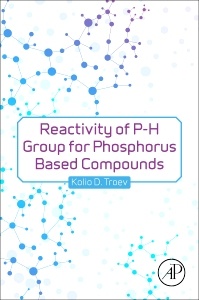Reactivity of P-H Group of Phosphorus Based Compounds
Auteur : Troev Kolio D.

Reactivity of P-H Group of Phosphorus Based Compounds bridges the gap between inorganic and organic phosphorus compounds, providing a basis to explore the myriad possibilities for synthesis of novel low and high molecular phosphorus-containing compounds. It covers well-documented reactions in detail, including: tautomerization, oxidation, reduction, alkylation, oxidation coupling, addition reaction to: carbon-carbon multiple bonds, Schiff base, isocyanates, nitriles, epoxides; addition to carbonyl group, Kabachnik- Fields reaction, cross-coupling reaction and more. In an accessible style complete with synthetic routes and figures, the resource then covers the reactivity of multiple P-H group members: phosphines, phosphine oxides, hypophosphorus acid, H-phosphinic acids and polys(alkylene H-phosphonate).
This valuable coverage supports the advancement of research and applications in this area for scientists solving a scientific problem or starting a variety of new projects, such as a new reaction for the synthesis of biologically active compounds, new methods of polymer synthesis or a new methodology for polymer modification.
Chemistry researchers in synthesis, in academia and industry
He was a director of the Institute of Polymers, Bulgarian Academy of Sciences from November 2003 to February 2012.
- Describes the diverse reactivity of the phosphorus-hydrogen group, perhaps the most powerful in organic chemistry
- Includes practical information for the synthesis of catalysts, biologically active substances, flame retardants, advance materials and polymer materials
- Offers a visually-accessible guide to important reactions by an internationally recognized chemist
Date de parution : 09-2017
Ouvrage de 464 p.
15x22.8 cm
Thèmes de Reactivity of P-H Group of Phosphorus Based Compounds :
Mots-clés :
Acidity; Addition reaction; Addition reactions; Alkylation; Cross coupling reactions; Cross dehydrogenative coupling; Cross-coupling reaction; Cross-coupling reactions; Cross-dehydrogenative reactions; Crosscoupling reactions; Dehydrogenative coupling; Diesters of H-phosphonic acid; Electrooxidation; H-Phosphinic acid; H-phosphinate; H-phosphinic acid (hypophosphorous acid); H-phosphonic acid; Hypophosphite; Hypophosphite borane complexes; Hypophosphorous acid; Nonoxidative chlorination; Oxidation; PKa values; Phosphine oxides; Phosphines; Phosphine-boranes; Phosphinic dipeptide analogs; Poly(alkylene H-phosphonate)s; Poly(phenylphosphinoborane); Reduction; Tautomerization phosphine oxides; Transfer hydrogenation; α-Amino H-phosphinic acid; α-aminophosphonates



